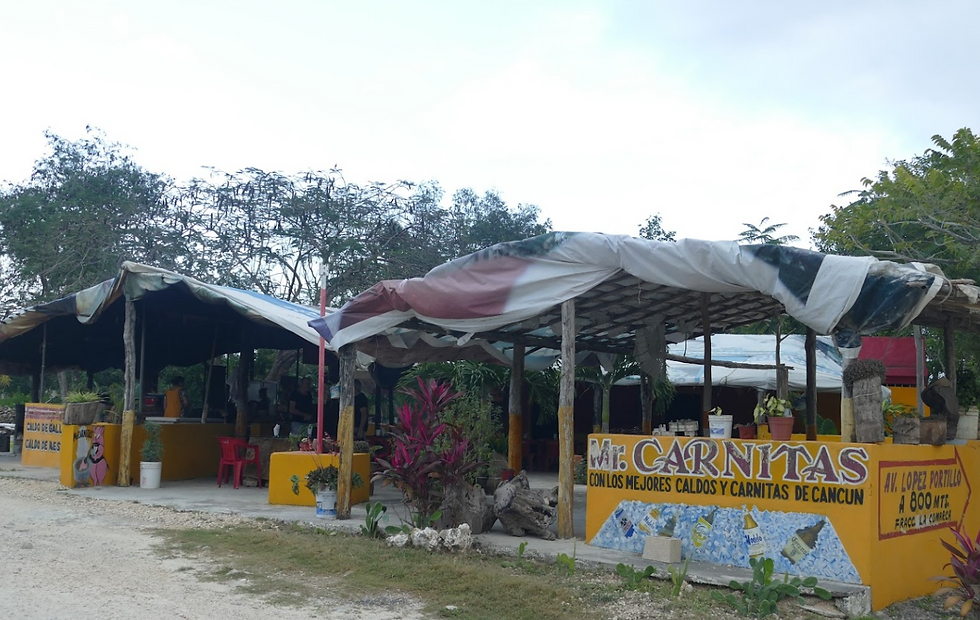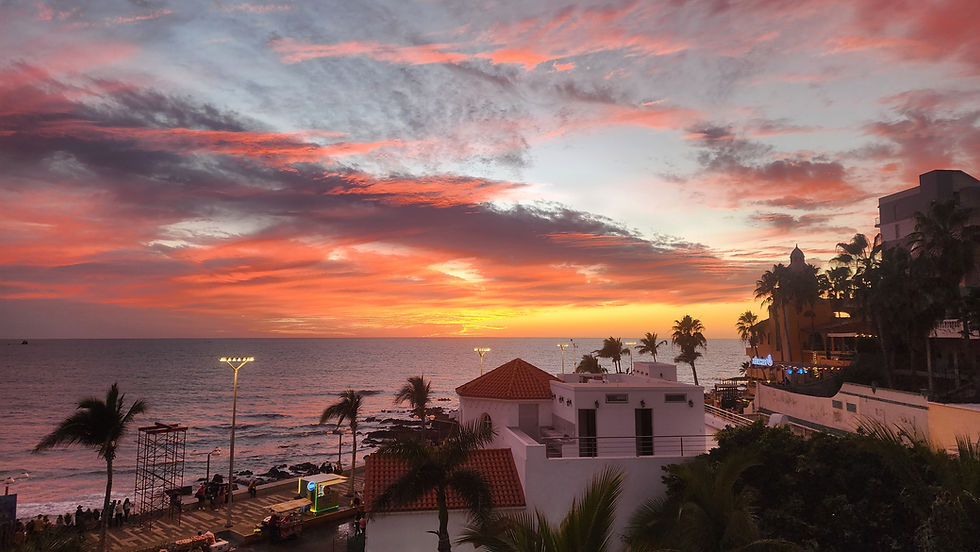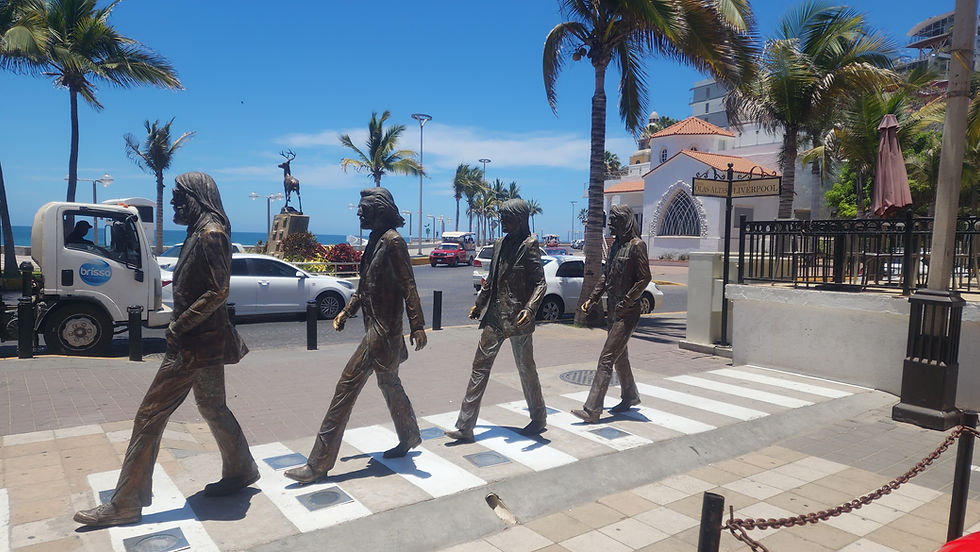Morocco to Miami to Merida, Mexico
- Bil
- Jan 19, 2022
- 9 min read

Our plan was to get closer to the States before the new Covid surge locked everything down. Morocco had just suspended all flights with the UK, Sweden & Germany, but Mexico seemed to be wide open. Direct flights from Casablanca to Cancun were outrageous, but fares from there to Miami and Miami to Cancun were not bad.
So, we had a quick, 2-day stay in South Florida, seeing Skylar & a couple friends, and getting our booster shots. Susie was already feeling a bit peaked from the last few days of Morocco, and the booster really knocked her for a loop. By the time we landed in Cancun she was ready to crash, but we still had a 4-hour bus ride to get to Merida. The seats were ok, and everyone was masked, but the ADO Bus was full and it was a long ride.
Arriving at the Merida bus station long after dark we took a taxi to the Santa Ana Hotel in the old part of town. Our room was on the 2nd floor, overlooking the courtyard and small pool. Hibiscus, bougainvillea and other lovely plants added to the tropical ambience. Santa Ana Square was 1 block away, so we walked over for a quick dinner al-fresco before return to the room and hitting the bed.
Merida is a vibrant city of a million souls, with a thriving ex-pat community. Founded by a Spanish conquistador in 1542, Merida is the capital of the state of Yucatan, situated about 35 km south of the Gulf of Mexico. The centro histórico district is one of the largest in the Americas, lined with majestic homes built by millionaires, made rich from growing henequén.

Santa Ana Square near our hotel was much smaller, presided over by the 300-year-old Parroquia Santa Ana (Catholic Church). Restaurants and souvenir shops lined the square, and one area was usually occupied with fitness freaks, running wind-sprints and doing calisthenics. We vowed to participate….later.
Two days after arriving Susie was feeling great, but I started sneezing. Didn’t think too much about it as I go through sneezing episodes occasionally. Then my nose started running – a lot. And I started to just generally feel like crap. Unfortunate, as Susie had perked up and was ready to go exploring. And she did – off to the market, and the dentist, and all over town while I laid in bed waiting impatiently for a quick recovery from an annoying cold.
Meanwhile…Dia de los Muertos! One of the main reasons we chose Mexico at this time was to experience this iconic celebration that occurs in the beginning of November. The Day of the Dead is actually a multi-day event with family and friends gathering to honor deceased ancestors. Ofrendas (altars) are set up in homes and public places with food & drinks, yellow marigolds and photos of the deceased, to encourage them to pass through to this side for the day. Traditionally, the first two days are more private: the first being for children that have passed and the second for adults.

The next day is the grand finale and more of a public celebration, with folks dressed up with decorated calaveras (skulls) and elaborate costumes for parades and socializing. Children in some areas walk the streets in costumes, asking for calaveritas (small gifts) – likely a merging of the tradition of trick-or-treating at Halloween in the US.
There are more than 40 indigenous cultures in Mexico and the Mayans represent a large part of the population in the Yucatan. They observe Hanal Pixan – a celebration similar to Dia de los Muertos where altars are adorned with a green cross symbolizing Ya’axhce, the sacred ceiba tree, a lit candle and four gourds with atole–a corn-based drink for the returning pixans (souls). The four gourds represented the cardinal points of the ceiba tree. They place 7 stacks of 13 tortillas to remember the numbers of their calendar, 4 bowls with meat and pork.
By 2019, the 3rd day parade in Merida involved hundreds of participants and attracted tens of thousands of spectators. Sadly, it was cancelled in 2020 because of Covid and again this year. There were still many ofrendas setup in parks and shop windows, with related t-shirts and souvenirs on sale. Susie saw a small parade of mostly children on the first night. I was in bed blowing my nose. The next day we walked down to the Plaza Grande which was very busy locals & visitors, observing the large altar and many vendors & pop-ups lining the streets.

Next evening, we strolled over to Santa Ana square looking for a bite, and someone asked if we would like to come in for the show. OK – sure. Into the Café del Sol, a small room with a dozen tables and a tiny platform against the far wall. The entertainment was a couple in calaveras makeup performing traditional dances, with costume changes between. They were joined by a young girl and a woman for one dance, and a guitarist came out and played a short set. Very serendipitous!
There were many restaurants within walking distance – mostly variations on Mexican. I had never been a real fan of mole sauce but really enjoyed it at El Apapacho. Pan & Koffee was our fav breakfast joint where they baked all their own bread and large variety of pastries – scrumptious! Had to get there early or be prepared for a long wait.
Seven days went by fast and was now time to move north – where we had rented a villa on the beach in Progreso. One last breakfast at Pan & Koffee and grab a taxi for the 30-minute ride to Casa de Playa Arpe, Arturo’s name for his little spot of paradise on the beach. It had 3 large bedrooms and 4 baths on 2 levels, nice kitchen, washer & dryer, with an upstairs balcony and a lower deck and pool looking out on the sandy beach. There was a kite-surfing shop two doors down, and a tiny police shack with a spinning blue light running 24/7. Male & female officers constantly rode up and down the beach on quads.

My head cold was gone but now Susie was feeling some of the same symptoms, and (drum roll here} we both noticed our sense of taste was diminished. Great. Walked to a clinic in the main part of town for Covid tests. 40 USD each. Results were emailed next day: Susie was positive & I was negative. Pretty sure I had it also. So. Doesn’t change our plans here much as we mask all the time – just won’t be going out to eat. Get some groceries & stay in. And hope we test neg for return flight in 10 days.
Progreso is a popular beachside destination for the Yucatan peninsula, located on a long barrier island facing north into the Gulf of Mexico. Sandy beaches welcome families while the prevailing winds attract hordes of kite surfers. Arturo left a nice kayak for us and Susie and I both enjoyed paddling up and down the coast in the mornings before the wind picked up,
A dozen fishing boats were kept on the beach in front of us – about 6 meters long with crude wooden poles sticking out the front and back, supported by a wooden mast. Early every morning when the winds were light a group on people would arrive on foot and scooters, and an old truck with the small outboard engines. Women & children would help rig the boats, clamping on the engines and filling the bait buckets with crabs. Ready for a day’s fishing, the boats were rolled into the water on logs and one man in each boat would putt-putt off into the distance.

Sometime in the afternoon the boats would return. They must have been watching each other as they all came back about the same time. I didn’t see any cell phones, but maybe they had some. The support group would flock back to the beach to help with unloading the vessels. Most boats had a large load of octopus that were unceremoniously dumped into plastic bags and hauled away.
One gentleman showed me his fishing rigs. Four handlines of heavy monofilament, with large lead weights and pieces of crab tied on the end. No hooks. One line went up to the front boom and one to the rear – I guess acting as outriggers. My guess is that once they reached a likely fishing spot, the angler would throw out the lines and let them drag along the bottom as the boat drifted. (I didn’t see any anchors). I suppose they would periodically haul the lines in, and (hopefully) peel off a hungry octopus, still munching on the crab pieces.
The pulpo maya o rojo (red octopus) fishery is a mainstay of the Yucatan, with landings over 12,000 tons during the season from August to December 15th. Most of the catch is shipped to Europe, Japan and the US, with the rest consumed locally. Favorable weather conditions and re-opening of world markets contributed to a record season for pulpo fishermen in 2021.

Our neighbor was a relative of Arturo, and on the 3rd day of our stay she brought over a couple of dishes for us: a bowl of hot pulpo soup and a platter of chilled pulpo salad. We were both reluctant to eat octopus since they are such amazing and intelligent creatures, but I made an exception considering Maria’s generosity. The soup was delicious with a great flavor and bits of pulpo. The salad was a type of ceviche, where the protein is broken down by citrus juices (typically limes), and combined with onions, peppers and cilantro, although Mexican chefs often cook the pulpo beforehand. Very tasty.
When arriving on the beach at Progreso, the 6.5-kilometer-long Puerto de Altura dominates the view. The Yucatán Peninsula is formed from a limestone shelf that tapers off very slightly into the ocean, necessitating a very long pier to allow large ships to dock. Touted as the longest in the world, the Progreso Pier used stainless steel reinforcing rods and has outlasted many other structures using standard rebar. The landward section is called the High Port, built with arches to allow water flow beneath, lessening the impact on surrounding waters & beaches. The longer, seaward section is called the Fiscal Pier, and rests directly on the seabed. Environmental and erosion impact has been observed on the nearby beach.

The intersection where the Puerto de Altura meets the shore divides Progreso, with a busier tourist and commercial area to the east and residences and smaller shops westward. Strolling along the wide Malecón (waterfront promenade) on the east side we saw sections of umbrella-covered tables on the beach side where vendors served meals or charged exorbitant prices to sit and picnic. A wide variety of restaurants, cafes and shops lined the other side of the walk, with some small food carts offering churros, tacos & Mexican crepes (forgot what they were called). Evenings were very busy with many couples and families walking around, with the kids carrying lighted balloons and getting their faces painted.
The Malecón has been extended westward but for now consists only of a nicely landscaped walkway along the beach, with a few sculptures and food carts on weekends. City officials have been counting on increased business from Cruise ships which has been slow to materialize. Most cruisers that do come to Progreso usually board buses and drive directly to Merida or one of the amazing Mayan ruins like Chichén Itzá, bypassing the local merchants in Progreso.

Remember the meteor that sent our planet into another ice-age 68 million years ago? The one that wiped out most plant and animal life on earth? The impact was just offshore from Chixulub, 30 km east of here, hitting with a force of up to 900 billion atomic bombs. Tsunamis swept the oceans of the world while ejected dust and particles blocked sunlight for decade. Through the millennia the 150 km diameter crater has been filled in, but a large number of cenotes mark the circumference. The crystal-clear waters are popular spots for swimming and diving.
We spent most of our time staying isolated at Casa de Playa Arpe, using the kayak or reading on the beach. We walked 30 minutes to the grocery store in town where everyone was masked and took an Uber back. Two days before our flight to Miami we got more Covid tests which both came back negative that afternoon. We celebrated with a nice dinner at Crabster on the Malecón.

Instead of taking the bus for the 4-hour ride back to Cancun airport we opted to hire a taxi. We had a nice conversation with Beba during the drive as he described life in the Yucatan, and his plans to buy more rental property when we could. He asked if we were hungry and suggested stopping at a favorite place of his just outside of the airport. Mr. Carnitas was a tiny spot beside the road with picnic tables under canvas & fiberglass panels, and a couple folks cooking tacos, tortas and quesadillas over a wood fire. Delcious, authentic local Mexican food.

Cancun airport was again very busy with long lines to check in and go through security and Covid checks. We got to the gate with an hour to spare, and sat, and sat and sat. Finally, the gate agents announced the flight was moved to another gate, so off we went. Another 2 hours later we were told the flight was cancelled so we would be bused to a local hotel. After a hectic, late night and early return to CUN we actually lifted off around 7:30, landing in Miami two hours later.
What’s next? Christmas holidays with kids & friends, and then? We’ll see……








Comments